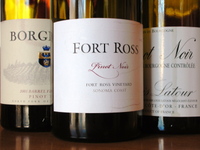When it comes to food-friendly versatility, it’s hard to do any better than pinot noir. But, as you may have noticed, there aren’t many pinots made on Long Island and those that are out there tend to be extremely inconsistent year to year or extremely expensive for the quality.
Of course, there is a reason for both the up-and-down quality and the sometimes-hefty price tags—pinot noir is extremely difficult to grow even under the best conditions. It is quite tolerant of cool and cold growing conditions, but because it is an early-leafing variety, it is extremely susceptible to spring frosts.
Pinot vines are also not very vigorous and sometimes lack adequate leaf coverage to protect the fruit from birds, which is a common problem on Long Island because we’re right in the migratory paths of many birds.
And, even if the grapes survive the birds and other maladies, the thin-skinned and tender berries shrivel and dry out quickly if not picked promptly once ripe.
They don’t call it the heartbreak grape for nothing.
You could call it the bankbreak grape too, because I’ve rarely found a pinot noir for under $20 that is worthwhile.
But, last weekend we had my in-laws and our friends M and T over to try a few different pinots along side a slow roasted pork shoulder crusted with garlic, fennel seed, coriander seed and fresh herbs. Pork and pinot is a classic pairing and I think all agreed that this is one classic that holds true.
Of course, I also could have served dry Riesling or even Gruner Veltliner, but perhaps we’ll explore those another time. Today we’re talking about pinot.
We ended up with four wines—ranging in price from $12 to $39: one from the Burgundy region of France, two from California and one from the North Fork of Long Island. All four were tasted blind.
Far and away my favorite was the Fort Ross 2001 Fort Ross Vineyard Pinot Noir Sonoma Coast ($37) a gift from a certain obsessive. Unfiltered, the nose offered complex aromas of red cherry, cranberry, smoke, leather and dry earth. The palate featured similar flavors with delicate, dusty tannins and superior mouthfeel. It was also the best pairing with the pork roast.
The second-favorite wine of the night—both for me and for my dining companions—was Castello di Borghese’s 2003 Barrel Fermented Pinot Noir ($39). Almost as complex as the Fort Ross, its nose featured cherries, earth and barnyard aromas. A little less delicate, the palate was still refined and well-suited to the dinner table. I’ve long enjoyed Borghese’s pinots and this wine continues that tradition of quality, even if the minerality that I usually love was absent.
The surprise, at least in terms of bang for your buck, was the bottle of Louis Latour 2005 Bourgogne Pinot Noir ($12). Its much more “New World” in style than many Latours, but the fruit-forward red berries were balanced with some earthy, tea-like flavors. I’ve had Burgundies for $50 or more that weren’t as good, even if it’s somewhat simple.
One thing that all six of us agreed upon was the dud wine of the night—Angeline 2005 Pinot Noir Mendocino County ($14). Light-bodied, simple and juicy, this is the kind of pinot noir that you expect
when you order house pinot by the glass at a middling restaurant. And that’s not a good thing.
Don’t bother with it—seriously

